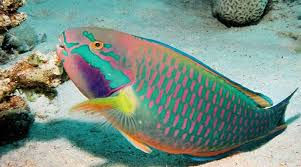Parrotfish, Poop, and Sandy Beaches
- Alyssa Allen

- Mar 1, 2021
- 3 min read
Hello my fellow curious critters and welcome back to The Friendly Neighborhood Shark Lady! I am going to apologize in advance if today’s post ruins the beach for anyone. Just try not to think about it the next time you’re sinking your feet into the nice, warm sand. Science is just kinda gross sometimes, and that’s ok. Honey is tasty bee puke and a lot of the sand that makes up beaches just so happens to be parrotfish poop. The world is weird and wonderful. Now, let’s learn all about the amazing parrotfish and how we have them to thank for our beautiful sandy beaches.

Like always, we will start with the basics, but don’t worry, there are a lot of weird fun facts when it comes to parrotfish. In fact, they are my favorite non-shark fish because they are so weird. There are around 80 different species of parrotfish, but that number could change (we will talk about why later). Parrotfish can be found hanging out around tropical coral reefs all over the world. They typically range in size from under 1 foot to around 4 feet (0.3-1.2 meters). On average, parrotfish live to be 5-7 years old. Their diet consists of algae found growing on and in different corals. Parrotfish are diurnal, meaning they are active during the day and sleep at night. They are not consumed for their meat globally, but are considered a delicacy in some countries in the South Pacific.

Now, I know you are all dying to know how beaches are made up of parrotfish poop, and I am more than happy to tell you. Like I said earlier, parrotfish eat algae that grow on and in different corals. Parrotfish also happen to spend about 90% of their day eating. This almost constant eating helps corals remain clean and healthy by preventing overgrowth of algae and clearing space for new baby corals to attach and grow. While they are eating the algae, bits of coral are broken off and pulverized by the crushing teeth found along the fish’s throat. The pulverized coral remains undigested and is expelled from their body as poop, which then turns into the sand found around coral reefs and along beaches. In fact, studies have shown that one fish can produce up to 2,000 pounds (907 kilograms) of sand each year!
Remember when I said that the number of parrotfish species may change? Well, there are a few different reasons. First of all, parrotfish have the ability to change their sex. They are protogynous hermaphrodites, meaning they start out life as functioning as females and later transition into males. Parrotfish are also notorious for drastically changing their coloring both between life stages (juvenile to adult etc.) and between genders. At one point, scientists believe there were over 300 different species because of these drastic differences!

One of my favorite facts about parrotfish is the fact that some species secrete a mucous cocoon when they sleep at night. They have an organ on the top of their head that secretes a clear mucous that surrounds the fish like a cozy little cocoon. Scientists aren’t 100% sure what the purpose of their mucous cocoon is, but they believe it helps mask their scent. This can help protect them while they sleep from nocturnal predators like the moray eel by making them harder to find.
Most parrotfish species are listed as “least concern” by the IUCN Red List, but a couple of species are listed as “near threatened” and many species have decreasing populations. Around the globe, we are seeing a drastic decrease in the health of our coral reefs and in the populations of animals that call them home due to overfishing, ocean acidification, and climate change. Some species, like the Bumbhead parrotfish, are also being heavily overfished to the point of local extinction. The Bumphead parrotfish is now extinct in Guam and drastically depleted in Fiji, Samoa, Papua New Guinea, and some other parts of the Solomon Islands due to overharvesting.
Thank you for coming along and learning with me today! Again, I’m sorry if I ruined beaches for you, but don’t you think parrotfish are cool?! I love them so much and greatly appreciate all the sand they make that I get to dig my toes in and enjoy. What other weird animals do you want to learn more about? Let me know below! I’ll see you all back here soon for more science fun!
Sources:
https://www.iucnredlist.org/search?query=parrotfish&searchType=species





Comments